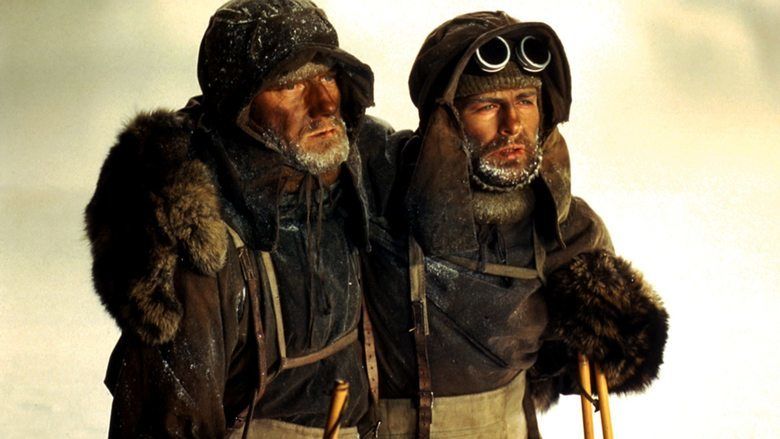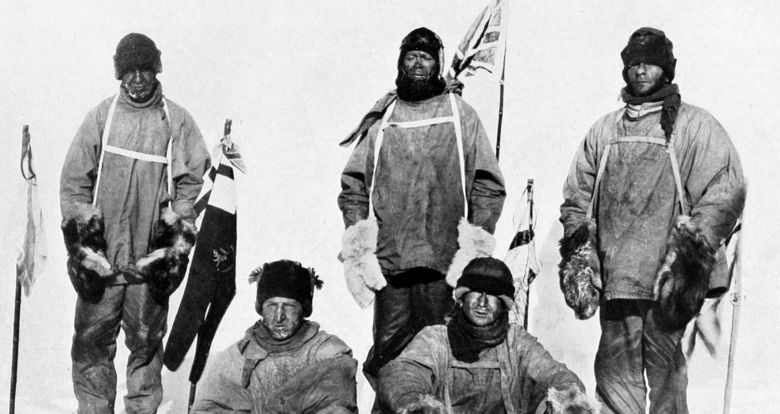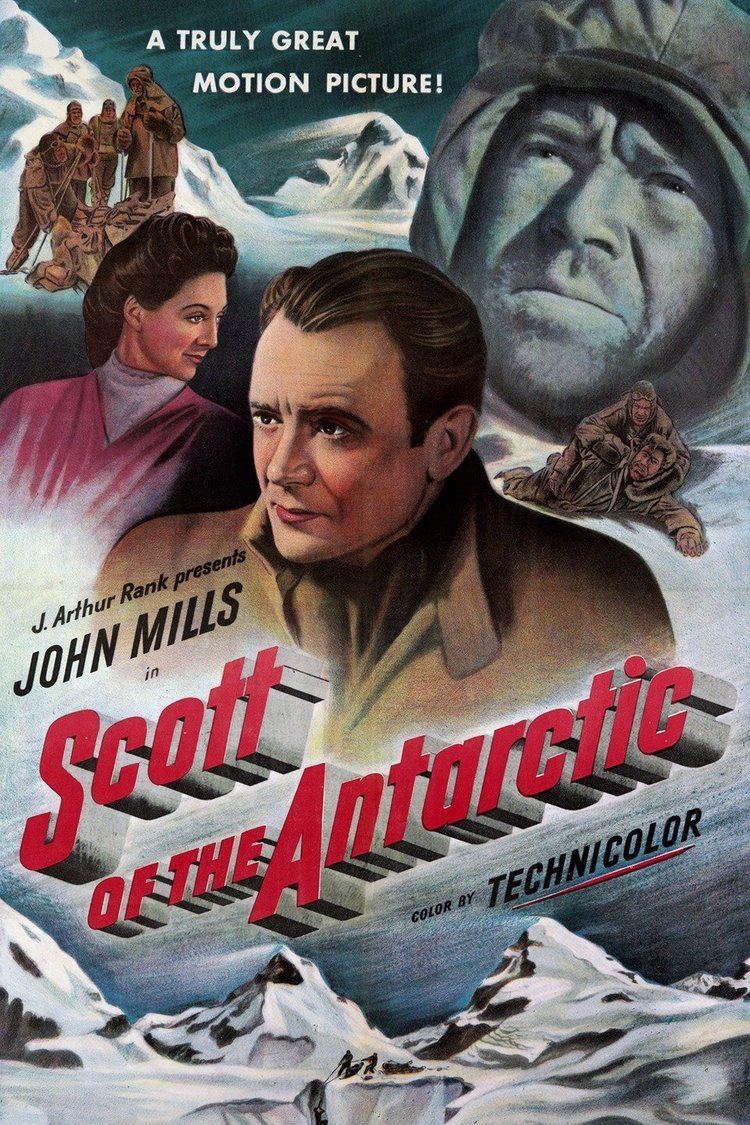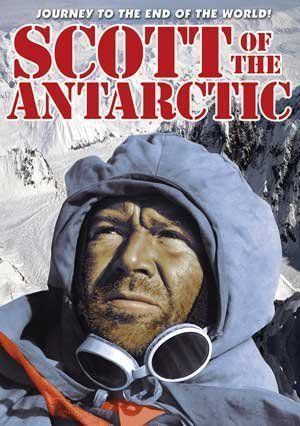Scott of the Antarctic (film)
7 /10 1 Votes
Language English | 7/10 IMDb Genre Action, Adventure, Biography Duration Country United Kingdom | |||||||||||||||||||||||||||||||||
 | ||||||||||||||||||||||||||||||||||
Release date 29 November 1948 (1948-11-29) (UK) Cast (Captain R.F. Scott R.N.), (Captain L.E.G. Oates), (Lt. E.G.R. 'Teddy' Evans R.N.), (P.O.'Taff' Evans R.N.) Similar movies Mawson - Life and Death in Antarctica , The Thing , The Last Airbender , Ice Age , A.I. Artificial Intelligence , Crossing the Ice - A journey to hell and back | ||||||||||||||||||||||||||||||||||
scott of the antarctic 1948 vaughan williams s original music
Scott of the Antarctic is a 1948 technicolour film which depicts Robert Falcon Scott's ill-fated Terra Nova Expedition and his attempt to be the first to reach the South Pole in Antarctica. John Mills played Scott, with a supporting cast which included James Robertson Justice, Derek Bond, Kenneth More, John Gregson, Barry Letts and Christopher Lee.
Contents
- scott of the antarctic 1948 vaughan williams s original music
- Royal command film performance scott of the antarctic 1948
- Plot
- Acknowledgements
- Departures from the historical course of events
- Causes of the tragedy
- Reception
- References

Produced by Ealing Studios, the film was directed by Charles Frend and largely shot at the studios, with some landscape and glacier exteriors shot in the Swiss Alps and in Norway; no actual scenes were made in Antarctica, though some pre-war stock footage from Graham Land may have been used. The film was made in Technicolor. The script was by Ivor Montagu, Walter Meade and the novelist Mary Hayley Bell, Mills' wife. The film is also known for its score by Ralph Vaughan Williams that was later reworked into his Sinfonia antartica.

The film is largely faithful to the real events of the ill-fated polar trek, with emphasis on the stoic character of Scott and the hostility of the Antarctic environment.

Royal command film performance scott of the antarctic 1948
Plot

Captain Scott is given the men, but not the funds, to go on a second expedition to the Antarctic. As his wife works on a bust of him, she tells him that she's "not the least jealous" that he's going to the Antarctic again. The wife of Dr. E. A. Wilson, whom Scott hopes to recruit, is much less enthusiastic, but Wilson agrees to go on condition it is a scientific expedition. Scott also visits Fridtjof Nansen, who insists that a polar expedition must use only dogs, not machines or horses. Scott goes on a fundraising campaign, with mixed results, finding scepticism among Liverpool businessmen, but enthusiasm among schoolchildren who fund the sledge dogs. With the help of a government grant he finally manages to raise enough money to finance the expedition.

After a stop in New Zealand, the ship sets sail for Antarctica. Once there, a camp is set up at the coast, and a small contingent of men, ponies and dogs begins the trek towards the pole. About halfway, the ponies are shot and some of the men are sent back with the dogs. At the three quarter mark, Scott selects the five-man team to make the push to the pole. They reach the pole only to find the Norwegian flag already planted there and a letter from Roald Amundsen asking Scott to deliver it to the King of Norway.

Hugely disappointed, Scott's team begins the long journey back. When reaching the mountains bordering the polar plateau, Wilson shows the men some sea plant and tree fossils he has found, also a piece of coal, to Scott's satisfaction, proving that the Antarctic must have been a warm place once, and opening economic possibilities. The perceived lack of such opportunities had been one criticism leveled at Scott while fundraising. Nevertheless, Scott is increasingly concerned about the health of two of his men: Evans, who has a serious cut on his hand, and Oates, whose foot is appallingly frostbitten. Evans eventually dies and is buried under the snow. Realising that his condition is slowing the team down, Oates sacrifices himself by walking out of the tent into a blizzard to his death after saying "I'm just going outside and may be away some time." Finally, just 11 miles short of a supply depot, the rest of the team dies in their tent after being trapped by a blizzard, with Scott writing the famous "I do not regret this journey…" entry in his diary.

Months later, a search party discovers the tent and the bodies. Scott's diary is also recovered, allowing the members to learn of the polar party's fate. The film ends with the sight of a large wooden cross with the five names of the dead inscribed on it as well as the quote : "To strive, to seek, to find, and not to yield." (A line from the poem "Ulysses", by the Victorian era poet Alfred, Lord Tennyson.)
Acknowledgements

At the start of the film, consulted survivors and relatives of late members of Scott's expedition are thanked for their help: "This film could not have been made without the generous co-operation of the survivors and the relatives of late members of Scott's Last Expedition. To them and to those many other persons and organisations too numerous to mention individually who gave such able assistance and encouragement, the producers express their deepest gratitude."
Departures from the historical course of events
There are several minor differences between the film and the true course of events:
In the film, Scott receives a telegram in New Zealand, but does not read it for himself or to the crew until his ship is en route to the Antarctic. It says: "I am going south. Amundsen". Scott and his crew immediately comprehend that Amundsen is heading for the South Pole. Historically however, Scott received this telegram a little earlier, in Australia, and Amundsen's true text was less clear: "Beg leave to inform you Fram proceeding Antarctic Amundsen." [Fram is Amundsen's ship]. As Amundsen had publicly announced he was going to the North Pole, the real Scott and his companions did not initially grasp Amundsen's ambiguous message, according to Tryggve Gran's diary (Gran was Scott's only Norwegian expedition member).
In the film, the Terra Nova disembarks Scott's team in the Antarctic, sails along the ice barrier without Scott and unexpectedly discovers Amundsen's Antarctic base camp. The ship therefore returns to Scott's base camp and informs Scott about Amundsen's presence in the vicinity. In historical fact, Scott was not at his base camp during this unscheduled return of his ship, but was busy laying depots in the interior of the Antarctic.
In the film, just before reaching the South Pole, Scott's team sight a black flag planted by Amundsen, and the men realise the race is lost. In the next scene, the men arrive at Amundsen's empty tent (flying a Norwegian flag) at the South Pole, and discover the paw prints of Amundsen's sledge-dogs. In historical reality, Scott and his men discovered the paw prints (and dog excrement) on the previous day at the black flag.
The film gives the impression that Scott asks himself at the South Pole whether he can manage to return to base camp safely. In reality, Scott wrote in his diary that he wished "to get the news through first" (both Scott and Amundsen had lucrative agreements with the media on exclusive interviews), but Scott realistically doubted whether he could do it (i.e., beat Amundsen to the cablehead in Australia). This error in the film is based on a small omission in the originally published diary, an omission that was rediscovered long after the film was produced.
Causes of the tragedy
Given that some of the real expedition members were still alive at the time of filming and were consulted, the film documents the causes for the tragedy as they were seen at the time (1948). These causes are alluded to discreetly throughout the film:
Reception
Scott of the Antarctic was the third most popular film at the British box office in 1949.
References
Scott of the Antarctic (film) WikipediaScott of the Antarctic (1948 film) IMDbScott of the Antarctic (film) themoviedb.org
